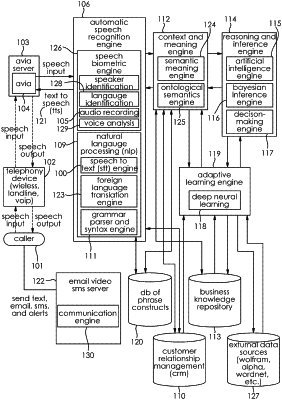| CPC G06N 5/04 (2013.01) [G06F 16/90332 (2019.01); G06F 40/30 (2020.01); G06F 40/35 (2020.01); G06F 40/58 (2020.01); G06N 3/042 (2023.01); G06N 5/022 (2013.01); G06N 7/01 (2023.01); G06N 20/00 (2019.01); G06Q 10/10 (2013.01); G06Q 30/016 (2013.01); G06Q 30/0613 (2013.01); G10L 15/1822 (2013.01); G10L 15/193 (2013.01); G10L 15/22 (2013.01)] | 17 Claims |

|
1. A conversational system comprising:
a microphone; and
a processor coupled to memory that includes:
a data structure object that includes a graph data structure comprising structure nodes, wherein the structure nodes include structure edges that define links between the structure nodes; and
a program that instructs the processor to perform:
receiving a first voice-based input via the microphone;
generating, in response to the first voice-based input, a knowledge-tree graph instantiation based on the data structure object, wherein the knowledge tree graph instantiation includes:
instantiation nodes based on the structure nodes; and
instantiation edges based on the structure edges, wherein the instantiation edges define links between the instantiation nodes;
receiving a second voice-based input via the microphone;
modifying the instantiation nodes based on the second voice-based input; and
modifying the instantiation edges based on the second voice-based input, such that modifying the instantiation nodes and instantiation edges results in the knowledge tree graph instantiation being different than the data structure object and other data structure objects stored in the memory.
|